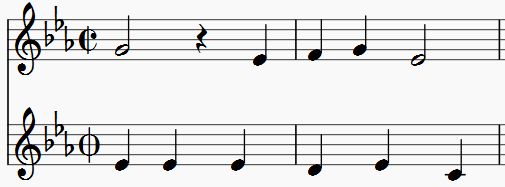Early music features
MuseScore offers several specialized functions to create engravings of early music (particularly medieval and renaissance) akin to commercial editions from the 20th century onwards.
Unbarred (or unmetered) notation
In MuseScore, notes lasting longer than the duration of a measure are normally tied across barlines. However MuseScore has a special feature which allows it to display the note values intact, without splitting and tying them in this way. This enables you to notate music which is unbarred (i.e. not divided into measures), such as that of the renaissance:
- From the menu bar, select Format→Style...→Score.
- Tick the box labelled "Display note values across measure boundaries … ."

- Click "OK" or "Apply." The existing score is immediately updated.
Example
- The example below shows an excerpt from the original score of "De Profundis Clamavi" for 4 voices by Nicolas Champion:

- The same excerpt displayed in MuseScore:

- And after activating "Display note values across measure boundaries … ."

- To get rid of the barlines, just untick the “Show barlines” box in the Staff / Part properties dialog. See also Mensurstrich (below).
Note: The feature is still in development and may contain bugs. The longest supported note value is the longa (a dotted longa is still broken up and tied over).
Mensurstrich
Since a complete lack of barlines could make performing the music more difficult for current musicians, many modern engravers settled on a compromise called Mensurstrich, where barlines are drawn between, but not across, staves.

To place barlines between staves:
- In the lowest staff (usually the bottom staff of a system) where the proposed Mensurstriche is required, uncheck "Show barlines" in the Staff/Part Properties dialog;
- In the staff above where you want the Mensurstriche, click on one barline;
- In the Barline section of the Inspector, tick the "Span to next staff" option;
- In the Barline section of the Inspector, adjust the "Span from" value so that the top of the barline meets the bottom line of the staff (e.g., set to 8);
- Click the "Set as staff default" button.
Ambitus
Before there was the concept of an absolute pitch, performers were required to transpose vocal music to a singable range for their ensemble "on the fly." To aid them, an ambitus was sometimes included, marking the entire range of a voice at the beginning of the piece.
To apply an ambitus, use one of the following methods:
- Drag the ambitus symbol (from the Lines palette of the Advanced workspace) onto a clef.
- Select one or more clefs, then click (double-click prior to version 3.4) the ambitus symbol (in the Lines palette of the Advanced workspace).

When applied, the ambitus automatically displays the note range of the score: if there is a section break then only the note range of the section is displayed. Beyond the section break a new ambitus may be applied.
The note range of the ambitus can be adjusted manually by selecting it and changing the "Top note" and "Bottom note" values in the Inspector. For automatic adjustment click the Update Range button in the inspector.
Mensural time signatures
In the mensural notation system, time signatures did not define the length of a measure, but the length of breves and semibreves. MuseScore supports mensural time symbols as a display method in the Time signature properties dialog rather than as symbols, but they are just for show, as the proportion of e.g. half notes per whole notes cannot be modified.
One way to make use of these symbols is to replicate when composers of the renaissance had multiple voices in different time signatures simultaneously without using tuplets. Edit the time signature on a per-staff basis, as long as the beginning and end of a measure in all staves match up. If they do not, then consider increasing the size of the measures to the lowest common denominator.

De Profundis Clamavi for 5 voices by Josquin Des Prez
Period tablature
Authentic-looking period tablature is possible for instruments such as the lute, theorbo etc. The various historical styles are well supported by a choice of fretmark and note symbol fonts, optional “upside-down” tablature, and special symbols for bass-string notes. See Tablature.